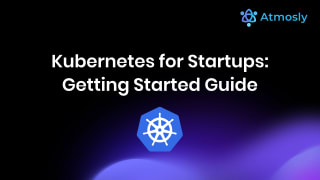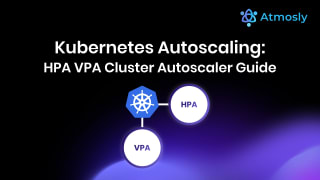Kubernetes is the leading platform for deploying and managing containerized applications, trusted by businesses worldwide. While Kubernetes offers powerful automation and scalability, managing it effectively can be complicated. Tasks such as resource management, security enforcement, optimizing configurations, and controlling costs often become overwhelming.
Atmosly simplifies Kubernetes management, directly addressing these common challenges. Designed specifically to streamline Kubernetes operations, Atmosly helps your team manage resources efficiently, enhance security, optimize configurations, and gain clear visibility into costs—making Kubernetes easier, safer, and more cost-effective.
Challenges of Kubernetes Management

While Kubernetes automates many parts of application deployment, managing Kubernetes itself comes with several challenges:
Steep Learning Curve
Kubernetes has many components (like etcd, kube-apiserver, kube-controller-manager, kube-scheduler, kubelet, kube-proxy) and complex networking. Teams need a lot of training and practice to manage it well.
Operational Overhead
Everyday tasks like creating clusters, upgrades, patches, scaling nodes, storage management, load balancing, and keeping the system highly available need constant attention. This requires specialized DevOps or SRE teams.
Security Complexity
Securing Kubernetes means handling many different aspects:
- Network Policies: Controlling traffic inside the cluster.
- RBAC (Role-Based Access Control): Managing who can do what.
- Secrets Management: Safely storing sensitive information.
- Container Image Scanning: Checking container images for security risks.
- Runtime Security: Protecting applications while they run. Mistakes in these areas can create security risks.
Cost Management & Optimization
Without proper tracking, Kubernetes costs can quickly rise. Common issues are:
- Tracking costs accurately by team or app.
- Avoiding waste by correctly scaling nodes and pods.
- Dealing with unused resources and idle workloads. Good cost control needs regular oversight and good tools.
Monitoring & Observability
Knowing the health of Kubernetes clusters, how applications perform, and solving issues quickly means setting up monitoring, logging, and tracing tools like Prometheus, Grafana, ELK Stack, and Jaeger. Managing these tools properly adds complexity.
Multi-Cluster & Multi-Cloud Complexity
As companies grow, they often use multiple Kubernetes clusters across different environments (like on-premise, hybrid, and cloud). This brings extra complexity:
- Keeping configurations and security consistent everywhere.
- Managing multiple clusters easily.
- Ensuring compliance and audit across different setups.
Developer Experience
Giving developers easy, secure ways to deploy and manage apps without deep Kubernetes knowledge is challenging. You need:
- Simple interfaces or platforms hiding Kubernetes complexity.
- Self-service capabilities with good security to prevent errors.
- Balancing developer freedom with compliance and operational rules.
Backup, Disaster Recovery & Data Protection
Keeping applications safe from data loss means:
- Reliable backup and restore methods.
- Regular disaster recovery tests.
- Protecting data from loss or corruption, especially in multi-cluster setups.
Compliance & Governance
Meeting compliance requirements (like PCI DSS, GDPR, HIPAA) in Kubernetes means:
- Clearly enforced policies.
- Good logging and traceability.
- Safe management of sensitive data.
Ecosystem Management
The Kubernetes ecosystem has many tools and solutions that change quickly. Keeping them compatible, secure, and performing well requires ongoing attention.
Effectively managing these areas helps companies fully benefit from Kubernetes and successfully run cloud-native apps.
How Atmosly Simplifies Kubernetes Management
1. Simplified Learning and Enhanced Developer Experience
Managing Kubernetes doesn’t have to mean mastering every technical detail. With pre-built Infrastructure as Code (IaC) templates based on industry best practices, teams can deploy secure, consistent clusters without deep expertise. Ready-to-use Terraform modules and an intuitive UI allow developers and ops teams to focus on building, not babysitting infrastructure.
Key capabilities:
- Automated provisioning: Rapidly launch fully managed Kubernetes clusters using proven Terraform modules.
- Visual IaC management: Understand and manage infrastructure changes through a simplified interface.
- Best practices by default: Built-in enforcement of security and scalability standards.
- No deep expertise required: Developers can ship faster without learning the entire Kubernetes stack.
Make it easy to launch secure, production-ready clusters—no Kubernetes deep dive required. Spin up your first cluster in minutes
2. Reduced Operational Overhead
Manual management slows teams down. Automated workflows, CI/CD integrations, and built-in scaling reduce daily toil and shift focus to high-value work.
What’s included:
- Easy application deployment via intuitive workflows.
- Auto-scaling & node management based on real-time resource needs.
- Self-healing and proactive alerts to maintain uptime and stability.
- Continuous health monitoring to ensure your clusters stay production-ready.
3. Robust Security Management
Security is built into every layer—from infrastructure to workload. The platform actively scans for vulnerabilities, flags misconfigurations, and helps enforce policies.
Security highlights:
- Real-time vulnerability scans with actionable insights.
- Automated compliance checks (CIS, PCI-DSS, SOC2).
- Recommendations for improving RBAC, closing exposed ports, and minimizing privilege escalations.
- Granular access controls across users and environments.
4. Effective Cost Management and Optimization
Kubernetes costs add up fast—especially without visibility. AI-driven insights help you right-size resources and cut waste.
Core cost features:
- Smart resource recommendations for CPU/memory optimization.
- Node utilization tracking and best-fit instance suggestions (e.g., Graviton, Spot).
- Detailed cost breakdowns by app, infra, and wastage.
- Scheduling to scale down non-prod environments after hours.
- Workload-level visibility for pinpointed savings.
5. Comprehensive Monitoring and Observability
Built-in observability tools make it easy to track performance, debug issues, and monitor usage—without extra setup.
Observability tools include:
- Real-time metrics at the cluster, node, pod, and container levels.
- Pod-level logging and access to container logs via the UI.
- Pre-integrated Prometheus, Grafana, and Loki stack.
- Live deployment and health status tracking.
- Intelligent alerts for anomalies and system failures.
6. Multi-Cluster and Multi-Cloud Management
Managing multiple clusters across different cloud providers can get messy. A unified control plane brings everything together.
Control capabilities:
- Centralized cluster view for AWS, GCP, Azure.
- Seamless onboarding of self-hosted or existing clusters.
- Cross-cluster config syncing and policy enforcement.
- Consistent governance across all environments.
7. Resilience, Compliance, and Ecosystem Automation
Backup, recovery, compliance, and integrations—all handled in one platform.
Highlights:
- Automated backups and disaster recovery for workloads and volumes.
- Continuous compliance monitoring (CIS, PCI-DSS, SOC2).
- Audit trails and automated policy enforcement.
- One-click deployment of Kubernetes add-ons and third-party tools.
- Pre-validated integrations via a built-in marketplace.
Conclusion
By automating key tasks and simplifying complex processes, Atmosly helps teams manage Kubernetes clusters with greater efficiency, security, and cost control. Whether it’s a single cluster or a multi-cloud setup, the platform delivers the tools needed to streamline operations and maximize performance.






